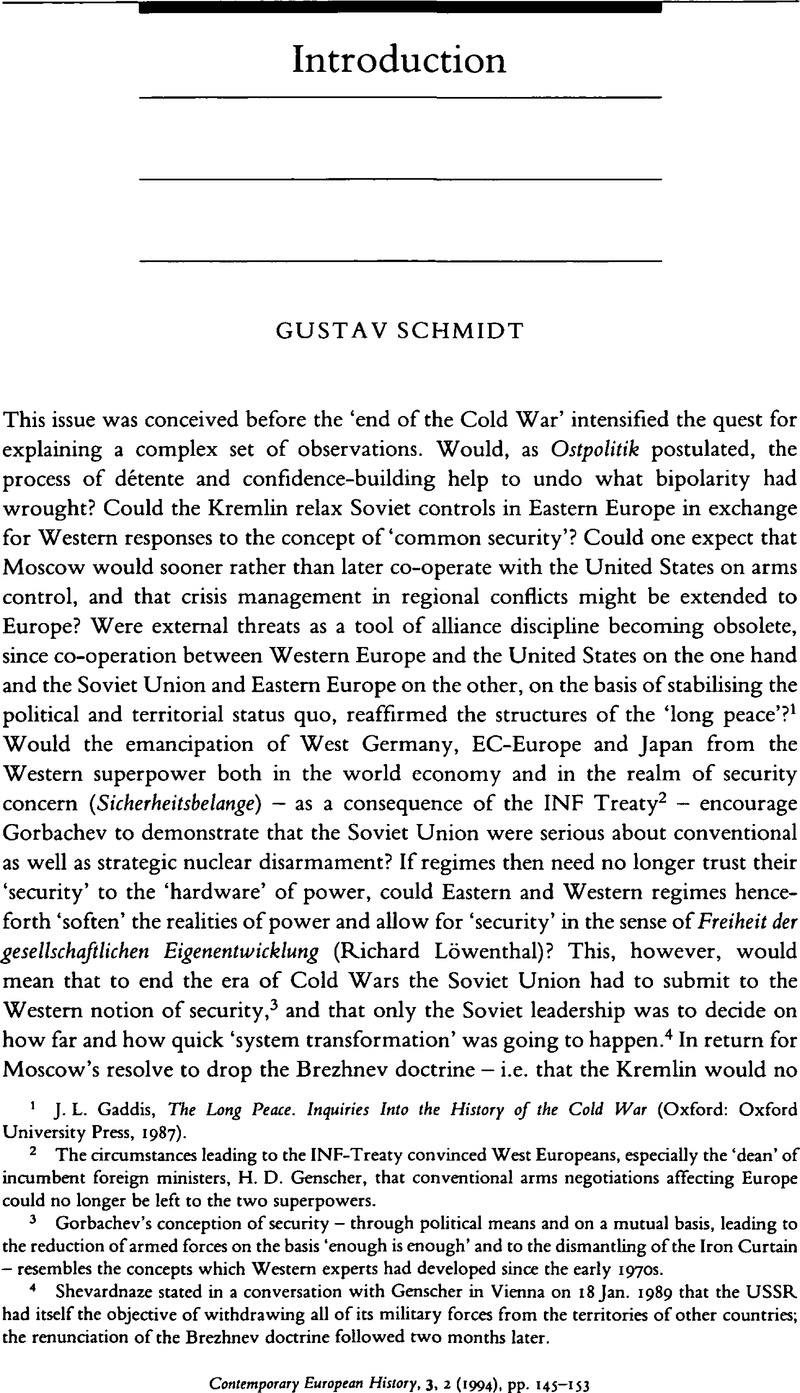No CrossRef data available.
Article contents
Abstract

- Type
- Introduction
- Information
- Copyright
- Copyright © Cambridge University Press 1994
References
1 Gaddis, J. L., The Long Peace. Inquiries Into the History of the Cold War (Oxford: Oxford University Press, 1987)Google Scholar.
2 The circumstances leading to the INF-Treaty convinced West Europeans, especially the ‘dean’ of incumbent foreign ministers, H. D. Genscher, that conventional arms negotiations affecting Europe could no longer be left to the two superpowers.
3 Gorbachev's conception of security – through political means and on a mutual basis, leading to the reduction of armed forces on the basis ‘enough is enough’ and to the dismantling of the Iron Curtain – resembles the concepts which Western experts had developed since the early 1970s.
4 Shevardnaze stated in a conversation with Genscher in Vienna on 18 Jan. 1989 that the USSR had itself the objective of withdrawing all of its military forces from the territories of other countries; the renunciation of the Brezhnev doctrine followed two months later.
5 Legvold, R., ‘War Weapons, and Foreign Policy’, in Bialer, S. and Mandelbaum, M., eds, Gorbachev's Russia and American Foreign Policy, 1987;Google Scholar cf. McGwire, M., Military Objectives in Soviet Foreign Policy (1987)Google Scholar; Dean, J., Watershed in Europe: Dismantling the East–West Military Confrontation (1987)Google Scholar.
6 Harrison Wagner, H., ‘What Was Bipolarity?’ (thereafter Wagner, ‘Bipolarity’), International Organization, Vol. 47, no. 1 (1993), 77–106.CrossRefGoogle Scholar
7 Reynolds, D., ‘Beyond Bipolarity in Space and Time’, in Hogan, Michael J., ed., The End of the Cold War. Its Meaning and Implications (thereafter Hogan, End) (Cambridge: Cambridge University Press, 1992), 245–56.CrossRefGoogle Scholar
8 Moreton, Edwina, ‘Gorbachev and the Warsaw Pact: The Politics of New Thinking’, in Freedman, L., ed., Military Power in Europe (thereafter Freedman, Military) (London: Macmillan, 1990), 62.Google Scholar
9 The references in intra-American decision-making to the case of Britain – and to the US as ‘heir to the British Empire’ – reflect the view that the US might lose its competitive edge if it fell into the trap of overcommitment.
10 Treverton, G. F., ‘America's Stakes and Choices in Europe’ (thereafter Treverton, ‘Stakes’), Survival, Vol. 34, no. 3 (1992), 119–35.CrossRefGoogle Scholar
11 Weber, St., ‘Shaping the Postwar Balance of Power: Multilateralism in NATO’ (thereafter Weber, ‘Shaping’), International Organization, Vol. 46, no. 3 (1992), 633–80.CrossRefGoogle Scholar
12 How could Europe face a USSR which by 1975 might achieve the position of second power in the world economy? This was one of the topics which the US had on its mind when it pressed for European integration.
13 Leffler, Melvyn, ‘Strategic Dimensions of the Marshall Plan’, Diplomatic History, Vol. 12, no. 3 (1988), 278.CrossRefGoogle Scholar
14 Wagner, ‘Bipolarity’, 79.
15 Bruce Cumings, ‘The Wicked Witch of the West is Dead. Long Live the Wicked Witch of the East’, Hogan, End, 88.
16 This is the tenor of the so-called Pentagon's version of a New World Order, March 1992; it provides a rationale for many tendencies in American global strategy, although the emphasis is different in the phases of the post-war era.
17 The US thought it could not wait until Britain and France felt confident enough to join together with a revitalised Germany, as the multipolar American concept had foreseen; ‘instead, the U.S. had to commit itself as a predominant factor in the European balance of power and in so doing reassure the French government that it would not face a Faustian choice between subservience to the Soviet Union and subservience to Germany’. Weber, ‘Shaping’, 650–1.
18 Garthoff, R. L., ‘Why Did the Cold War Arise, and Why Did It End?’, in Hogan, , End, 128 ff.Google Scholar
19 This relates in particular to European integration as a substitute for German unification; see my article in this issue.
20 Lundestad, Geir, ‘The End of the Cold War, the New Role for Europe, and the Decline of the United States’, in Hogan, , End, 196.Google Scholar
21 Marshall and Acheson took this position in 1947/49 to defend the departure from the tradition of American foreign relations; Dulles wanted the establishment of the EDC before consultations about zones of arms reductions should proceed.
22 Dulles, NATO Council meeting, 4 May 1956, FRUS, 1955–1957, vol. IV, 61–2.
23 Would the Messina initiative fare better than the EDC project? was the query in 1955/57. Could the conflict between the EEC-Six and the EFTA-Seven affect Western Europe's relations in the era of détente between the nuclear powers? The ‘transfer’ of the ‘magnet’ doctrine from West Germany towards East Germany to EC-Europe versus Eastern Europe was only effective in the short interval between 1989 and 1990.
24 Treverton, , ‘Stakes’, 122.Google Scholar
25 May, E., ‘The U.S. Government, A Legacy of the Cold War’, in Hogan, , End, 226.Google Scholar
26 Weber, ‘Shaping’, 660 ff. for the situation in 1957/61; Schmidt, G., ‘Die sicherheitspolitischen und wirtschaftlichen Dimensionen in den britisch-amerikanischen Beziehungen 1955–1967’, Militärge-schichtlichen Mitteilungen, Vol. 2 (1991), 107–42.Google Scholar
27 Alford, J., ‘Confidence-Building Measures in Europe: The Military Aspects’, in Freedman, , Military, 212.Google Scholar
28 Dulles, 4 May 1956, FRUS, 1955–7, vol. IV, 61–2.
29 Gardner, L. C., ‘Old Wine in New Bottles: How the Cold War Became the Long Peace’, in Kegley, C. W., ed., The Long Postwar Peace. Contending Explanations and Projections (New York: Harper Collins, 1991), 125–46.Google Scholar
30 Wagner, ‘Bipolarity’, 95 ff.
31 Brzesinski, Z., ‘The Cold War and Its Aftermath’, Foreign Affairs, Vol. 71 (1992), 31–49.CrossRefGoogle Scholar
32 Wagner, ‘Bipolarity’, 95 ff.
33 Hassner, Pierre, ‘The View from Paris’, in Gordon, L., ed., Eroding Empire (thereafter Gordon, Eroding) (1989).Google Scholar
34 The reverse side is the fear that the French might seek an arrangement with the USSR at Germany's expense.
35 Loth, W., ‘Die deutsch-französischen Beziehungen. Verständigung und Mißverständnisse’, in Ost–West Konflikt und deutsche Frage (München 1989), 159–72.Google Scholar
36 This process has been the subject of many studies; the outstanding ‘think piece’ is J. Joffe's article in Gordon, Eroding.


